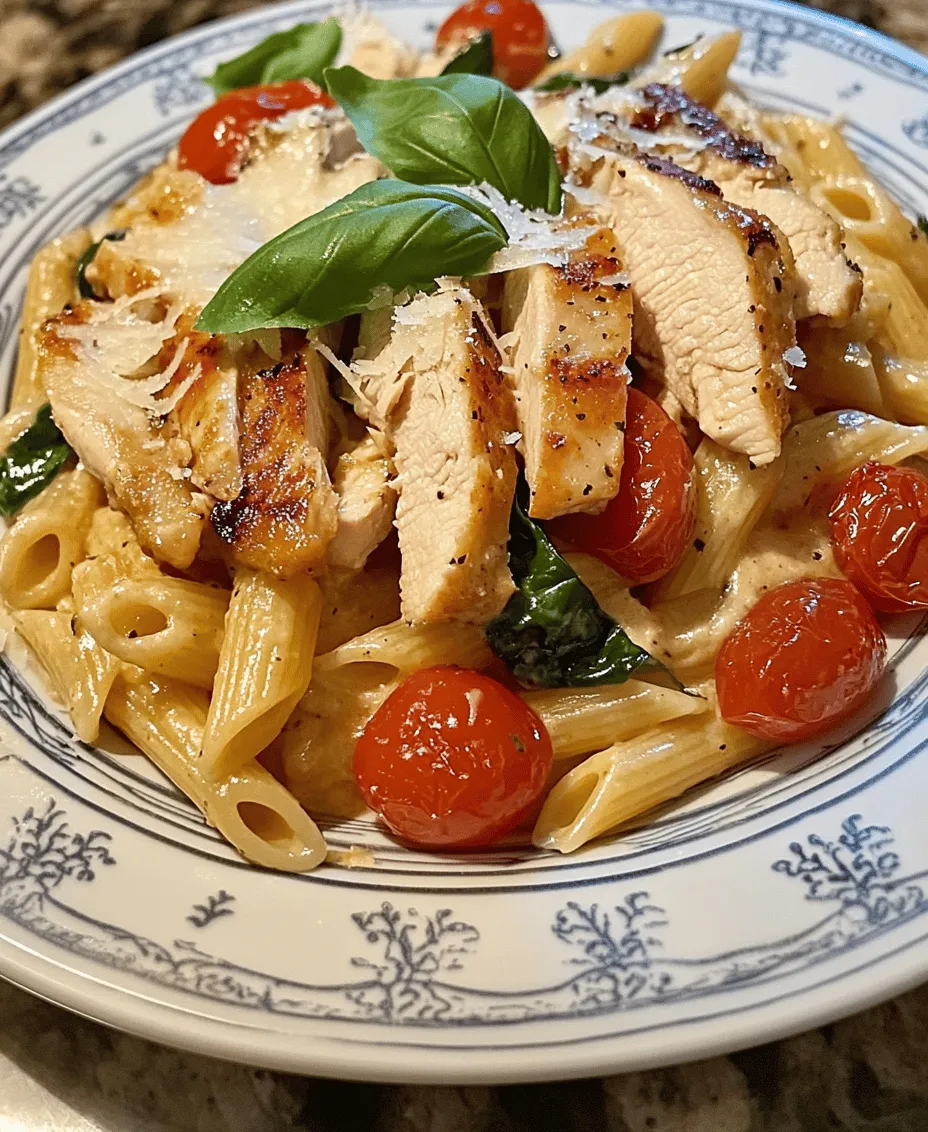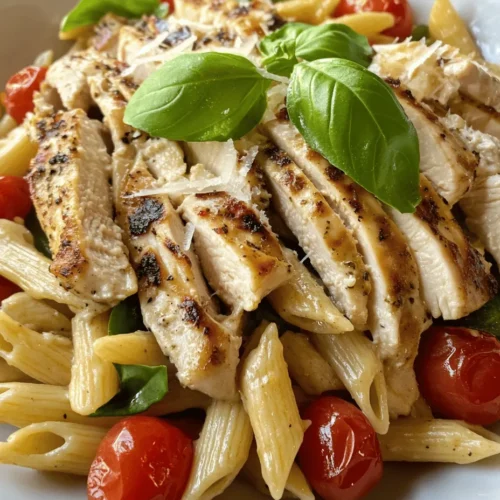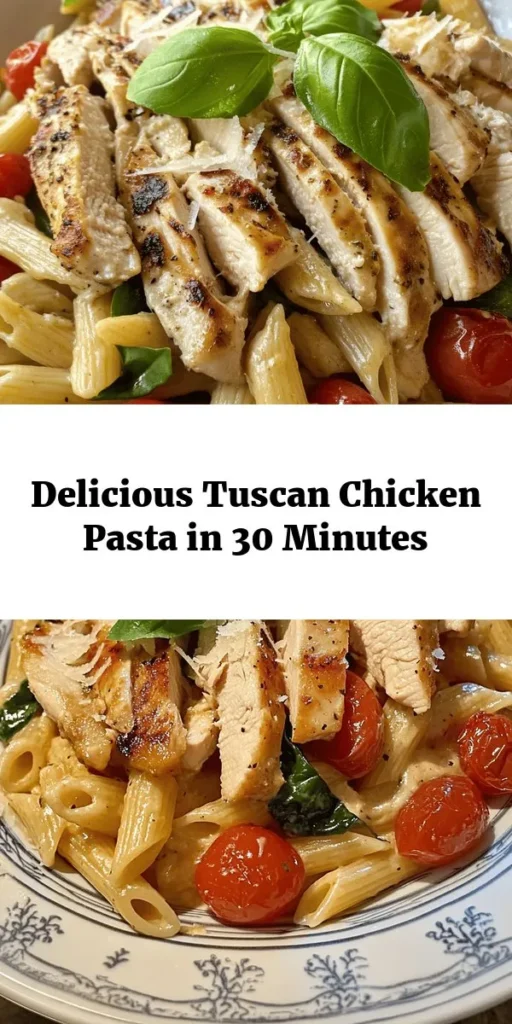Introduction
Tuscan cuisine is celebrated for its vibrant flavors, fresh ingredients, and rustic charm. Drawing from the rich agricultural heritage of the region, Tuscan dishes often feature high-quality produce, grains, and meats, all prepared with simplicity to highlight the natural flavors of each ingredient. This culinary tradition is not just about feeding the body; it’s about nourishing the soul and fostering community through shared meals.
One dish that embodies the essence of Tuscan cooking is the Tuscan Chicken Pasta Delight. This recipe serves as a perfect representation of the region’s focus on fresh, wholesome ingredients while offering a delightful combination of flavors that can transform any meal into a special occasion. Whether you’re looking for a comforting weeknight dinner or a dish that will impress guests at your next gathering, Tuscan Chicken Pasta Delight is sure to become a favorite in your household.
In this article, we will explore the key ingredients that make this dish so special and provide you with a step-by-step guide to preparing it. By the end, you’ll be equipped with the knowledge to create a truly authentic Tuscan experience in your own kitchen.
Understanding the Ingredients
To create a mouthwatering Tuscan Chicken Pasta Delight, it’s essential to understand the role of each ingredient used in the recipe. This not only enhances the cooking experience but also allows you to make informed choices when substituting or selecting ingredients.
Boneless, Skinless Chicken Breasts
The star of our Tuscan Chicken Pasta Delight is the boneless, skinless chicken breasts. They are a popular choice for many home cooks because they are lean, quick to prepare, and exceptionally versatile. When cooked properly, chicken breasts can be incredibly juicy and flavorful. To achieve this, it’s crucial to season them well and cook them just until they are no longer pink in the center. This will help retain moisture and ensure that your chicken is tender and succulent.
Pasta Varieties
When it comes to pasta, the choices are plentiful, but not all pasta types will work equally well in this recipe. For the Tuscan Chicken Pasta Delight, you might consider using fettuccine, penne, or farfalle. These pasta shapes have a sturdy texture that holds up well against the creamy sauce and chunks of chicken. Cooking your pasta al dente is key; it should be firm to the bite, ensuring that it doesn’t become mushy when combined with the sauce.
Olive Oil
Olive oil is a staple in Tuscan cooking, celebrated not only for its rich flavor but also for its health benefits. Rich in monounsaturated fats and antioxidants, olive oil is known to promote heart health and lower inflammation. In this dish, olive oil serves as the base for sautéing your chicken and vegetables, infusing them with a beautiful depth of flavor. Be sure to use high-quality extra virgin olive oil for the best results.
Garlic
No Tuscan dish is complete without garlic, which acts as a flavor enhancer in this recipe. Garlic not only adds aromatic depth but also brings a host of health benefits, including immune system support and antioxidant properties. Fresh garlic cloves should be minced or sliced and sautéed until fragrant, releasing their essential oils and enriching the overall flavor profile of the dish.
Dried Italian Herbs
A blend of dried Italian herbs, such as oregano, basil, and thyme, contributes to the robust flavor of this dish. These herbs are synonymous with Italian cuisine and can be easily substituted based on your preference or what you have on hand. Fresh herbs can also be used for a brighter flavor, but dried herbs are more concentrated and work wonderfully in this creamy pasta sauce.
Red Bell Pepper and Cherry Tomatoes
For a burst of color and nutrition, red bell peppers and cherry tomatoes are essential ingredients in the Tuscan Chicken Pasta Delight. Red bell peppers add a sweet, crunchy texture while providing vitamin C and antioxidants. Cherry tomatoes bring a juicy freshness that balances the richness of the cream and cheese. Their natural sweetness enhances the overall flavor of the dish, making it irresistible.
Spinach
Spinach is a fantastic addition to this recipe, not only for its vibrant green color but also for its health benefits. Packed with vitamins A, C, and K, as well as iron and antioxidants, spinach complements the dish perfectly. It wilts quickly, so adding it towards the end of the cooking process ensures that it retains its bright color and nutritional value.
Heavy Cream and Parmesan Cheese
To create the rich, creamy sauce that defines the Tuscan Chicken Pasta Delight, heavy cream and grated Parmesan cheese are essential ingredients. The heavy cream provides a luxurious texture, enveloping the pasta and chicken in a velvety coating. Meanwhile, the salty, nutty flavor of Parmesan cheese enhances the creaminess and adds an extra layer of depth. For an authentic touch, consider using freshly grated Parmesan, as it melts better and provides superior flavor compared to pre-grated varieties.
The Role of Salt and Pepper in Seasoning
Finally, salt and pepper are fundamental in elevating the flavors of each ingredient. Proper seasoning is crucial in any dish, and this pasta delight is no exception. Salt enhances the natural flavors of the ingredients, while freshly cracked black pepper adds a subtle heat. Always taste as you go and adjust the seasoning to your personal preference.
Step-by-Step Cooking Instructions
Now that you have a solid understanding of the ingredients, let’s dive into the step-by-step instructions for preparing Tuscan Chicken Pasta Delight. This guide will ensure that you achieve a delicious result every time you make it.
Cooking the Pasta
1. Bring a Large Pot of Water to a Boil: Fill a large pot with water, add a generous amount of salt (about 1 tablespoon per gallon), and bring it to a rolling boil. The salt enhances the pasta’s flavor and helps it cook evenly.
2. Add the Pasta: Once the water is boiling, add your chosen pasta. Stir occasionally to prevent it from sticking together. Cook according to the package instructions until al dente—this usually takes about 8-10 minutes, depending on the type of pasta.
3. Reserve Pasta Water: Before draining the pasta, reserve about a cup of the cooking water. This starchy water can be added to the sauce later if needed to achieve the desired consistency.
4. Drain and Set Aside: Once the pasta is cooked, drain it in a colander and set it aside. Do not rinse the pasta, as this removes the starch that helps the sauce adhere.
Preparing the Chicken
1. Season the Chicken: While the pasta is cooking, take your boneless, skinless chicken breasts and season both sides generously with salt, pepper, and dried Italian herbs. This will infuse flavor into the chicken as it cooks.
2. Heat Olive Oil in a Skillet: In a large skillet, heat a couple of tablespoons of extra virgin olive oil over medium heat. Once the oil is hot and shimmering, it’s time to add the chicken.
3. Cook the Chicken: Add the seasoned chicken breasts to the skillet, cooking for about 6-7 minutes on each side or until they are golden brown and cooked through (the internal temperature should reach 165°F). Remove the chicken from the skillet and let it rest on a cutting board for a few minutes before slicing it into bite-sized pieces.
Sautéing Vegetables
1. Add More Olive Oil: In the same skillet where you cooked the chicken, add a little more olive oil if necessary. You want just enough to prevent sticking and to sauté the vegetables.
2. Sauté Garlic and Red Bell Pepper: Once the oil is hot, add minced garlic and diced red bell pepper. Sauté for about 2-3 minutes until the garlic is fragrant and the peppers are slightly softened.
3. Add Cherry Tomatoes and Spinach: Next, add halved cherry tomatoes and fresh spinach to the skillet. Cook for an additional 2-3 minutes until the tomatoes begin to burst and the spinach wilts. Stir frequently to ensure even cooking.
4. Combine Chicken and Pasta: Finally, return the sliced chicken to the skillet, along with the cooked pasta. Toss everything together to combine. At this point, you can add a splash of the reserved pasta water if needed to help the sauce cling to the pasta.
This initial part of the cooking process sets the stage for a flavorful and satisfying meal that embodies the heart of Tuscan cuisine. In the next section, we will explore how to create the creamy sauce that ties this delightful dish together, ensuring that each bite is rich and satisfying. Stay tuned as we continue this culinary journey!

Combining Ingredients
To create a truly delightful Tuscan Chicken Pasta, the key lies in the careful combination of ingredients that ensures a well-balanced and cohesive dish. Start by cooking your pasta al dente according to package instructions. This step is crucial, as it helps the pasta maintain its texture while absorbing the flavors of the sauce later on.
Once your pasta is cooked, drain it and set it aside, reserving about a cup of pasta water. This starchy water will come in handy later to adjust the sauce’s consistency without losing flavor.
In a large skillet over medium heat, add a tablespoon of olive oil. Once the oil is shimmering, add your seasoned chicken pieces to the pan. The goal here is to achieve a beautiful golden-brown crust on the chicken. It should take about 5-7 minutes per side, depending on the thickness of the chicken. Once cooked through, remove the chicken from the pan and let it rest on a cutting board for a few minutes before slicing it into bite-sized pieces.
Next, in the same skillet, add the minced garlic and diced onions, cooking them until they become translucent and fragrant. This aromatic base is fundamental in building layers of flavor in your dish. Follow this with the addition of diced tomatoes and spinach. The tomatoes should be fresh or canned, depending on availability, and the spinach should wilt down nicely in the heat, creating a vibrant and colorful sauce.
Once the vegetables are softened, stir in your heavy cream and Italian seasoning. Allow this mixture to simmer for a few minutes, letting the flavors meld together. If the sauce appears too thick, gradually add some reserved pasta water until it reaches your desired consistency. Finally, toss the cooked pasta into the skillet, ensuring each piece is coated in the creamy sauce.
Add the sliced chicken back into the skillet, stirring gently to combine. Finish with a sprinkle of freshly grated Parmesan cheese and a dash of black pepper. Serve immediately, and you will have a beautifully combined Tuscan Chicken Pasta that is both satisfying and flavorful.
Serving Suggestions
Presentation matters, especially when serving a dish as appealing as Tuscan Chicken Pasta. To enhance the visual appeal, plate the pasta in shallow bowls. Twirl the pasta slightly for an elegant look and top it with the sliced chicken, allowing it to rest on the pasta instead of being buried under it.
Garnish with chopped fresh basil or parsley for a pop of color and freshness. A light drizzle of high-quality extra virgin olive oil can also elevate the dish, adding a glossy finish. If you want to impress your guests, consider serving the pasta with a side of crusty Italian bread and a simple green salad dressed with a light vinaigrette.
Nutritional Information
Understanding the nutritional breakdown of Tuscan Chicken Pasta Delight can help you appreciate its benefits. Each serving typically contains around 450 calories, 30g of protein, 20g of fat, and 45g of carbohydrates.
This dish is a great source of lean protein from the chicken, essential for muscle repair and maintenance. The combination of pasta and vegetables provides a healthy dose of carbohydrates to fuel your body, while the cream and cheese add richness and a satisfying mouthfeel.
For those with dietary preferences, this recipe is easily customizable. You can substitute gluten-free pasta for traditional pasta to accommodate gluten sensitivities. If you’re looking for vegetarian options, consider replacing chicken with sautéed mushrooms or grilled eggplant for a hearty and satisfying alternative, and use plant-based cream to maintain the creamy texture.
Culinary Techniques and Tips
Cooking techniques play an essential role in developing the flavors of your Tuscan Chicken Pasta. For instance, searing the chicken properly can enhance its natural flavor while creating a pleasing texture. Similarly, sautéing the garlic and onions to the perfect golden hue allows their sweetness to emerge, enriching the overall taste.
When it comes to ingredient substitutions for dietary restrictions, feel free to experiment with different types of pasta, such as whole wheat or chickpea pasta. These options not only cater to different dietary needs but also introduce unique flavors and textures to the dish.
Adjusting the spice level can also be easily achieved. If you prefer a bit more heat, consider adding red pepper flakes to the sauce. For a creamier texture, feel free to increase the amount of heavy cream or mix in some cream cheese or mascarpone for an indulgent twist.
Pairing Suggestions
Pairing your Tuscan Chicken Pasta with the right accompaniments can elevate your meal experience. A classic Italian white wine like Pinot Grigio or Verdicchio complements the dish beautifully, enhancing the creamy sauce without overpowering the flavors. If you prefer red wine, a light Chianti can also work well, balancing the richness of the pasta.
For side dishes, a simple arugula salad dressed with lemon and olive oil can add a refreshing contrast to the creamy pasta. Alternatively, roasted vegetables or a Caprese salad with fresh mozzarella and basil can bring additional color and flavor to your table.
Don’t forget about bread! A warm loaf of ciabatta or focaccia is perfect for soaking up any leftover sauce. These Italian breads not only taste great but also add to the authenticity of your Tuscan-themed meal.
Cultural Significance of Tuscan Cuisine
Tuscan cuisine is deeply rooted in the region’s agricultural traditions and reflects the simple, high-quality ingredients found in Italy. The use of fresh vegetables, herbs, and grains has shaped the culinary landscape of Tuscany, making it known for its rustic and hearty dishes.
Pasta plays a central role in Italian culture, and Tuscan pasta dishes are cherished for their ability to showcase local flavors and ingredients. This Tuscan Chicken Pasta Delight embodies these principles, bringing together the essence of the region’s cooking methods with comforting, familiar elements.
In Italian households, pasta is often a staple, enjoyed as a main dish or a side. This dish not only highlights the vibrant flavors of Tuscany but also serves as a testament to the communal experience of sharing food with family and friends.
Conclusion
Tuscan Chicken Pasta Delight is a versatile and satisfying dish that brings the flavors of Tuscany right to your home kitchen. Its simplicity and adaptability make it an excellent choice for any occasion, whether it’s a weeknight dinner or a special gathering with loved ones.
With its creamy sauce, tender chicken, and colorful vegetables, this dish is a celebration of Italian culinary traditions. We encourage you to explore more Tuscan recipes, allowing you to deepen your appreciation for the rich history and flavors of this beloved cuisine. Enjoy your culinary journey through Tuscany, one delicious dish at a time!



